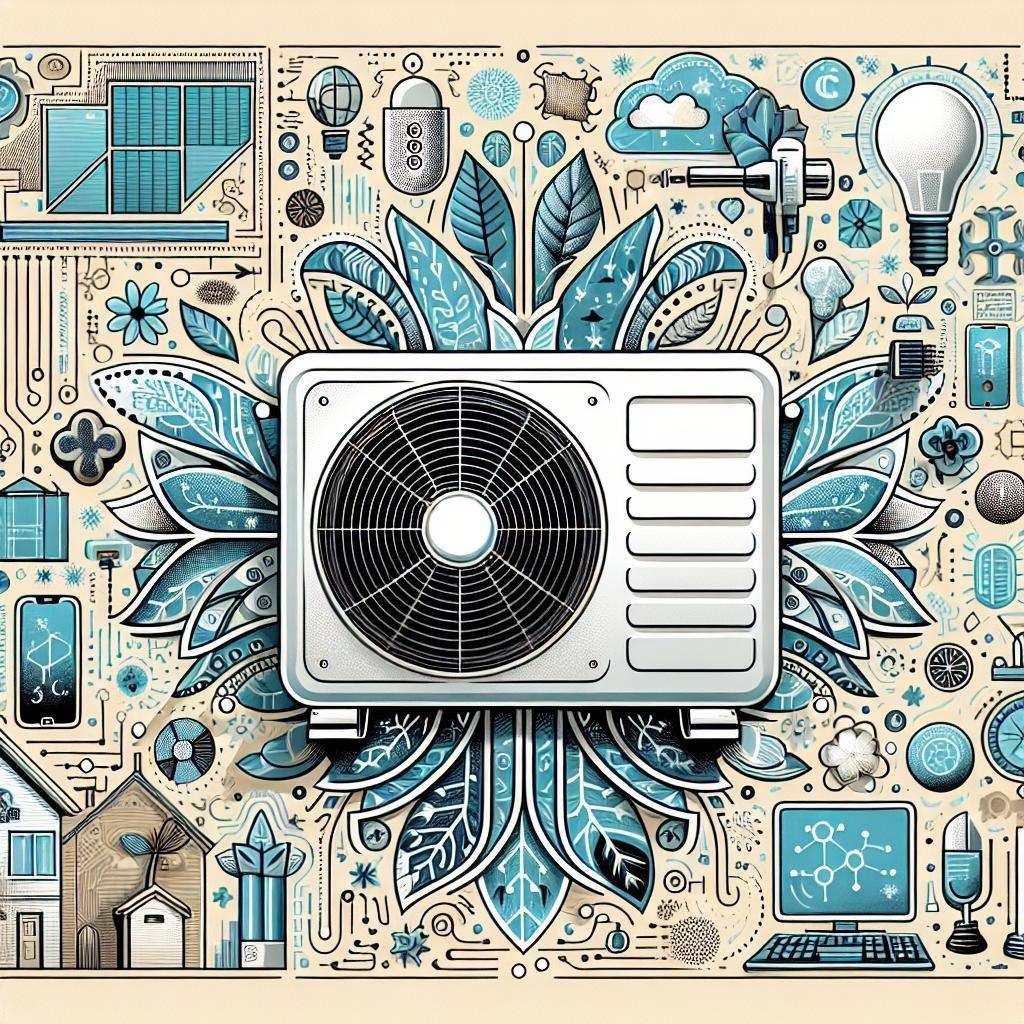In the bustling world of retail, where product visibility and customer comfort can make all the difference, the importance of an efficient climate control system cannot be overstated.As retailers strive to create an inviting atmosphere that encourages shoppers to linger longer, the choice of air conditioning plays a crucial role. Enter the mini split AC system—a compact,versatile solution that is redefining temperature management in retail spaces. With their sleek design, energy efficiency, and remarkable zoning capabilities, mini splits are proving to be not just a luxury but a necessity for modern retail environments. In this article, we will explore the myriad reasons why mini split AC systems have emerged as the preferred choice for store owners seeking to enhance both customer experience and operational efficiency.
The Efficiency of Mini Split AC Systems in Retail Environments
Mini split AC systems present a transformative solution for retail environments, where customer comfort directly influences shopping behavior. Their inherent adaptability allows for precise temperature control in designated zones, frequently enough outlined as follows:
- Zoned Cooling: Target specific areas of the store based on foot traffic or product displays.
- Energy Efficiency: Utilizes inverter technology to adjust cooling output, significantly lowering energy costs.
- Quiet Operation: Operates at decibel levels conducive to a pleasant shopping experience, allowing conversations and announcements to be heard clearly.
- Easy Installation: Requires minimal ductwork,making them ideal for both new constructions and retrofits.
Moreover,mini split systems enhance the overall aesthetic of a retail space. with sleek indoor units available in various designs, retailers can maintain their appealing ambiance without compromising on climate control. The functionality can be further demonstrated in a concise table format:
| Feature | Benefit |
|---|---|
| Flexible Installation | Adapts to unique store layouts |
| High SEER Ratings | Lower energy bills |
| Commitment to comfort | Improved customer satisfaction |
By integrating such systems, retailers not only secure an optimal shopping environment but also benefit from long-term energy savings and enhanced operational efficiency.ultimately, the advantages presented by mini split AC systems make them an ideal choice in maintaining a thriving retail atmosphere.

Tailored Comfort: Adjusting Zones for Maximum Customer Experience
One of the most significant advantages of mini split AC systems is their ability to provide personalized climate control for various areas within a retail space. Retail stores often have distinct zones tailored for specific needs, such as changing rooms, checkout counters, and product displays.By utilizing a mini split AC system, each zone can be independently controlled to achieve optimal conditions for both customers and merchandise. This ensures that the environment remains inviting and agreeable, which can significantly contribute to the overall shopping experience.
In addition to customizable temperature settings,mini splits can be programmed to respond to specific traffic patterns throughout the day. As an example, during peak hours, stores can enhance cooling in high-traffic areas while slightly reducing airflow in less frequented zones. This level of efficiency not only conserves energy but also reduces operational costs while maintaining customer satisfaction. Consider the following benefits of tailored comfort:
- Energy Efficiency: Individual control reduces unneeded energy consumption.
- Enhanced Product Preservation: Clothing,electronics,and perishables all require specific climates.
- Improved Customer Retention: A comfortable store encourages shoppers to stay longer.
Cost-effective Solutions: Saving Energy and Reducing Operating Expenses
Implementing mini split AC systems offers considerable energy savings, making them a wise investment for retail stores looking to lower their operating costs. These systems operate with high efficiency, utilizing inverter technology that adjusts the compressor speed according to the current cooling demand. This means that store owners can effectively manage the temperature without the energy waste associated with customary HVAC systems. Some benefits include:
- Zoning Capabilities: Individual control for different areas allows for tailored cooling, ensuring energy is not wasted in unoccupied spaces.
- Lower Energy Consumption: Mini splits generally consume less electricity, leading to lower utility bills each month.
- Reduced Maintenance Costs: With fewer moving parts and simpler designs, these systems frequently enough require less frequent maintenance.
Additionally, many mini split systems incorporate energy-saving features such as programmable thermostats and smart technology compatibility, further enhancing their efficiency. In a retail setting, where customer comfort is paramount, investing in mini splits not only keeps energy expenses down but also contributes to a pleasant shopping atmosphere. When comparing costs, consider the following:
| Feature | Traditional HVAC | Mini Split AC |
|---|---|---|
| Initial Cost | higher | lower |
| Energy Efficiency | Moderate | High |
| Maintenance Frequency | Frequent | Less Frequent |

Ease of Installation and maintenance: A Smart Investment for Retailers
When it comes to enhancing the shopping experience, the installation process of mini split AC systems offers unmatched convenience for retailers. Unlike traditional HVAC systems, mini splits require no extensive ductwork, which translates into a faster and more economical setup.Retailers can appreciate a smoother transition as these systems can be mounted on walls, ceilings, or floors, depending on specific store layouts. Their compact design allows for seamless integration into various environments, reducing disruption during installation. This not only saves time but also minimizes the impact on daily operations, allowing commerce to continue with minimal interruptions.
Maintenance is another area where mini split systems shine, making them a strategic choice for store owners aiming for efficiency. Regular upkeep is relatively simple and typically involves checking filters, cleaning coils, and ensuring the drainage line is clear. With fewer moving parts than conventional systems, the risk of mechanical failure diminishes, translating to lower service costs and improved reliability.Store owners will find that the long-term benefits of investing in these systems manifest as reduced energy bills and enhanced customer comfort, ultimately leading to increased sales. To further illustrate the advantages, consider the table below:
| Feature | Mini Split AC | Traditional HVAC |
|---|---|---|
| Installation Complexity | Easy; no ductwork needed | Complex; requires duct installation |
| Maintenance Frequency | Lesser intervention needed | Regularly intensive maintenance |
| Energy Efficiency | High SEER ratings | Lower efficiency in many models |
| Operational Disruption | Minimal | Potentially significant |
Q&A
Q&A: Why mini Split AC Systems are Ideal for Retail Stores
Q1: What are mini split AC systems, and how do they work?
A1: Mini split AC systems consist of two main components: an indoor air-handling unit and an outdoor condenser unit. They operate by using refrigerant to absorb heat from the indoor air and transfer it outside, creating a comfortable climate within the store.Since they don’t require ductwork, these systems provide a flexible and efficient way to cool or heat different areas of a retail space.
Q2: What are the benefits of using mini split AC systems in retail environments?
A2: Mini split systems offer several advantages for retail stores,including:
- Energy Efficiency: With the ability to control temperatures in individual zones,mini splits reduce energy consumption by only cooling areas that need it.
- Quiet Operation: retail environments benefit from the low noise levels of mini split systems, ensuring a peaceful shopping experience for customers.
- Space-Saving Design: these systems are compact and can be installed in various locations, which is ideal for stores with limited space.
- Enhanced Comfort: Retailers can customize the climate for different areas, such as dressing rooms or checkout areas, ensuring a pleasant experience throughout.
Q3: How do mini splits contribute to customer experience in retail stores?
A3: A comfortable shopping environment is crucial for enhancing customer satisfaction and encouraging longer visits. Mini split AC systems maintain consistent temperatures, eliminate drafts, and minimize humidity, all of which create a welcoming atmosphere. Happy customers are more likely to browse longer and make purchases, benefitting the retailer.
Q4: Are there any drawbacks to using mini split AC systems in retail spaces?
A4: While mini splits are highly effective, they may not be the right fit for every store. Initial installation costs can be higher compared to conventional systems, and if a store has extensive cooling needs, multiple units may be necessary. Moreover, regular maintenance is required to ensure they operate efficiently.
Q5: Can mini split AC systems be integrated with existing HVAC technology?
A5: Yes! Mini split systems can be easily integrated with existing HVAC systems. Retailers with central air can use mini splits to provide additional comfort to specific sections of their stores without revamping their entire system. This integration can definitely help balance cooling across various zones, creating a tailored experience for different store areas.
Q6: What should retailers consider when choosing a mini split AC system?
A6: When selecting a mini split AC system, retailers should consider factors such as:
- Cooling Capacity: Calculate the required BTUs to ensure adequate cooling for the space.
- Number of Zones: Determine how many areas need individual temperature control.
- Energy Efficiency Rating (SEER): Look for systems with higher SEER ratings for reduced energy costs.
- installation Requirements: Assess the infrastructure to ensure compatibility and accessibility for installation.
Q7: what are some best practices for maintaining mini split AC systems in retail stores?
A7: Regular maintenance is key to optimal performance. Best practices include:
- Cleaning Filters: Regularly clean or replace filters to ensure air quality and efficiency.
- Checking Condenser Units: Keep outdoor units free from debris and ensure proper airflow.
- Scheduling Professional Inspections: Have HVAC technicians perform annual maintenance checks to catch any issues before they become serious.
By using mini split AC systems, retail stores can create a comfortable, energy-efficient space that enhances the shopping experience. With thoughtful consideration and proper maintenance,retailers can harness the many advantages these systems offer to thrive in a competitive landscape.
The Way Forward
mini split AC systems emerge as the unsung heroes of retail environments, masterfully blending efficiency, versatility, and comfort. As we’ve explored, their ability to provide precise temperature control while minimizing energy consumption makes them a smart choice for store owners aiming to enhance the shopping experience.Moreover, the easy installation and aesthetic appeal of these systems allow retailers to maintain an inviting atmosphere without compromising on style. As you contemplate the optimal cooling solution for your retail space, consider the many benefits of mini split AC systems—a choice that not only cools your store but also cultivates a welcoming environment for customers. With the future of retail increasingly dependent on creating an engaging shopping atmosphere, investing in the right climate control could very well be your next strategic move.

